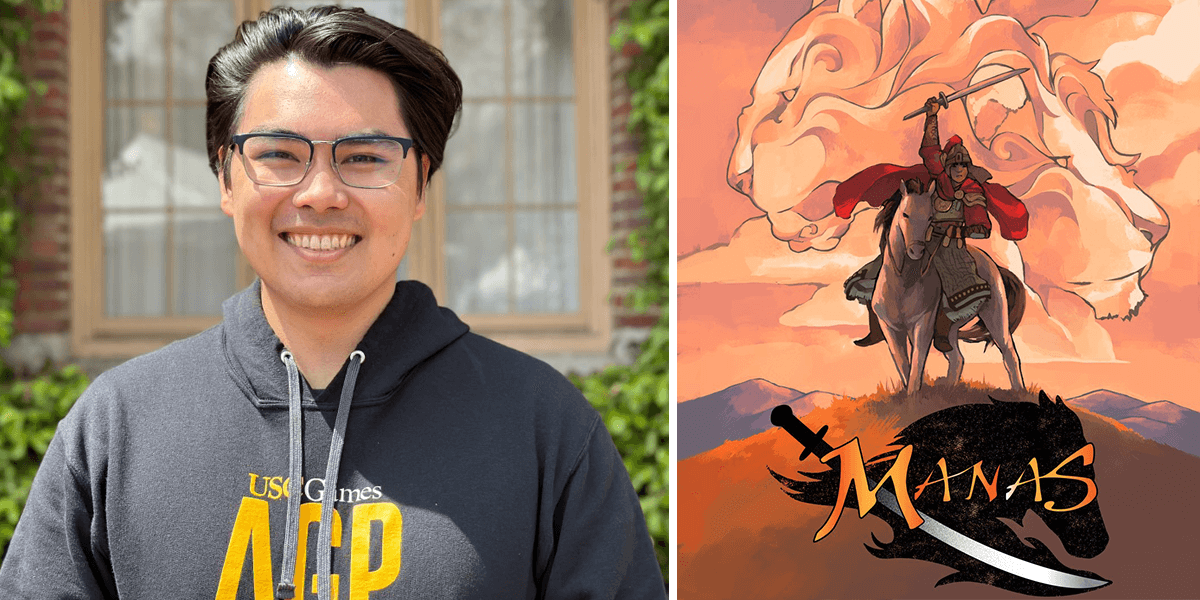
Omar Uraimov created a video game called Manas, based on the Kyrgyzstan legend, the Epic of Manas, the country’s most treasured cultural artifact. Photo/Gloria Jin.
Once upon a time, in a faraway land in the great Kyrgyz mountains, there was a boy named Omar Uraimov.
He was born in Bishkek, Kyrgyzstan, a country in Central Asia, where his family had lived for generations. But at the age of 5, Omar and his parents moved to the bustling city of Houston, Texas, to pursue the great American dream.
Gone were the rugged “celestial mountains,” vast plains, and pristine lakes of his homeland, replaced by high-rise buildings, highways, and sprawling suburbs. He was proud of his heritage, but as he grew older, he started to feel like he was losing touch with his roots. He saw little representation of his culture in his new home. He longed to share his stories, but he didn’t know how to do it.
Fast-forward 15 years, and Uraimov found the answer: a video game based on the Kyrgyzstan legend, the Epic of Manas, the country’s most treasured cultural artifact. The immersive game, which takes players on a journey through Kyrgyz culture through the eyes of its hero, Manas, will be one of 10 specially selected Advanced Games Projects presented at the USC Games Expo on May 10.
“It seemed like a perfect opportunity to both explore my own heritage and introduce it to so many people who probably have never heard of Kyrgyzstan,” said Uraimov, who graduates on May 12 with a B.S. in Computer Science, Games.
“The fact that it’s an improvisational epic that is influenced by its performers made it a really organic match for an interactive media form like a video game.”
The perfect stage
Kyrgyzstan (pronounced Kur-gis-tan) is a landlocked country in Central Asia with a rich and complex history. It became part of the Mongol Empire in the 13th century, later fell under the rule of various Central Asian empires, and finally became part of the Soviet Union from 1919 to 1991. Now independent, Kyrgyzstan is largely unknown outside of the region.
“One thing that I struggled with growing up is that Kyrgyz culture, and Central Asian culture in general, is not just underrepresented in media, it’s not represented at all,” said Uraimov. “It’s like we don’t exist.”
“One thing that I struggled with growing up is that Kyrgyz culture…is not just underrepresented in media, it’s not represented at all.” Omar Uraimov.
Uraimov was first captivated by the Epic of Manas while researching his heritage in middle school. It tells the story of a legendary hero named Manas, who unites the Kyrgyz people and leads them to freedom. Its premise: 40 tribes of the Kyrgyz people are divided and scattered across Central Asia, driven out of their homeland by an enemy faction.
“When I heard that story, I thought: that’s a video game,” said Uraimov. “That’s 40 objectives and 40 areas to explore. It just made sense to me. I thought it would be a really cool way to adapt this story and introduce it to people.”
Last spring, the time finally came for Uraimov to bring his vision to life. He created the game as part of the USC Games Advanced Games Project (AGP), the program’s core capstone class, where undergraduates from the USC Viterbi School of Engineering and the USC School of Cinematic Arts collaborate with students across USC to create polished games.
First, Uraimov fleshed out the idea in a directing class led by Tracy Fullerton, an experimental game designer and professor of cinematic arts, interactive media and games.
“Omar was the first computer science student to take my directing class and it was so great to see him grow and mature as a creative leader,” said Fullerton. “He workshopped the concept, deeply researching the original story that it is based on and thinking about how to bring this classic hero to a game.”
Bringing the vision to life
After working on the narrative in Fullerton’s class, Uraimov pitched his idea for AGP, a competitive, multi-round process. Last April, he got the green light to lead the game and set to work recruiting a team of 20 students, including engineers, game designers, producers and artists, to bring his vision to life.
“Omar was the first computer science student to take my directing class and it was so great to see him grow and mature as a creative leader.” Tracy Fullerton
“What I really was happy about was how many students came to me, telling me how interested they were in the subject matter and learning more,” said Uraimov.
“I think AGP exemplifies what USC stands for in terms of collaboration, because those projects are a collaboration from students from all over the university.”
As well as computer science and cinema students, the team included a composer from Thornton School of Music, artists and designers from the Otis College of Art and Design and Cal State Fullerton and marketing students from Marshall School of Business.
In Uraimov’s version of the tale, Manas is struggling with his duty, and finds a deeper spiritual understanding through his journey. It echoes Uraimov’s experience, managing a large team of students from across the university, maintaining a shared vision and staying on deadline.
“It’s a massive workload,” said Uraimov. “I could easily be putting in 30 or more hours a week on this project alone. But one of the most integral things to the identity of the Kyrgyz people is that we are united. Whatever the struggles are, we come back together. I can see this in—I wouldn’t quite say my stubbornness—but in my determination.”
His greatest source of pride? The game’s technical soundness. The team is the first from USC Games to work in Unreal Engine 5, the latest version of a powerful 3D games engine.
“Omar and his team challenged themselves and gained the invaluable experience of developing the game in the gold standard for modern game development as well as virtual production,” said Jim Huntley, associate professor and founder and executive producer of the USC Games Expo. “The team has delivered impressive quality throughout the game’s development.”
Childhood ambition fulfilled
Uraimov also recruited expert testers for the game: his brother Elim and his parents, Aibek and Bermet, who moved to California after Uraimov graduated high school.
“I’ve been showing my parents that game every single week as we make progress,” said Uraimov. “They’ve actually been a really great help to make sure the game is authentic—details like the style of the fence, or the name or color of the horse.”
After graduation, Uraimov will join Ripple Effect Studios, a gaming studio owned by Electronic Arts, as a software engineer. It’s a dream come true for Uraimov, fulfilling his childhood ambition of working in the gaming industry.
“Growing up, you hear that game development is not a realistic career, or it’s really difficult to break into it,” said Uraimov. “But USC is the best program in the world for a reason. It’s because it makes achieving those things possible.”
So, has anyone in Kyrgyzstan played the game yet?
“We’re waiting for the final reveal,” said Uraimov. “My mom said she doesn’t want to send it to anyone while it’s still in progress, because as soon as she does, it’s going to be all over the country overnight. I’m really excited for people in Kyrgyzstan to get their eyes on this.”
Published on May 5th, 2023
Last updated on May 8th, 2023












